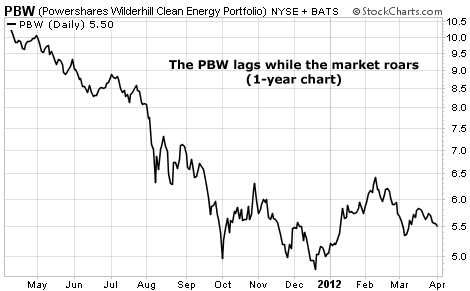| Home | About Us | Resources | Archive | Free Reports | Market Window |
The Best Exit Strategy for Any InvestmentBy
Tuesday, April 3, 2012
So... when do YOU sell?
What? You don't know? How could you not have any kind of plan?
Let's say you hold shares of Apple today at over $600 a share. You bought them a couple months ago below $400 a share. When is the right time to sell?
Look, this is your hard-earned money... I'm sure you don't want to lose it. And I'm sure you spent plenty of time figuring out what you wanted to BUY and when. But how will you know when to SELL?
Today, I'll show you how...
If you don't have an exit plan, you're not alone... I would bet that 99.9% of investors don't know when they're going to sell, either.
"It is the No. 1 mistake investors make," Dr. Richard Smith told me as we sat down for coffee yesterday. "They have no plan for when to sell. Ultimately, that results in occasional big losses, which permanently affect their portfolio."
Richard would know... He has a Ph.D. in mathematics. He has a powerful team of database programmers working for him. And he has studied and crunched the numbers on stocks and portfolios in every way you can imagine.
"What is the best exit strategy to use to prevent those big losses?" I asked him. "Is it a percentage trailing stop, a volatility-based trailing stop, a dollar-loss-based stop, some other exit plan... what?"
Here's what he told me: "The best exit strategy is the one PEOPLE ACTUALLY USE."
He said, "Steve, actually, your 25% trailing stop is brilliant. It's incredibly simple. It gives the average stock enough room to fulfill its upside potential... Yet it kicks you out if you got it wrong. There's no need to mess with that."
He wasn't flattering me... He was making a point that what we're talking about here is not a mathematical issue. It's about emotions...
"It's just ridiculous that people get attached to their stocks and ride them all the way down," Richard told me.
"But our brains are wired to avoid being wrong... We have an urge to be right and a desire to avoid regrets. All of those things are working against us in the stock market."
The point here is, we often have emotional trouble selling a stock at a loss... But a successful trade is made up of two parts: a good buy and a good sell. If we want to make money in the long run, we need to learn how to sell.
"Real winners in the markets are investors that can actually pat themselves on the back when they take a loss," Richard explained. "These folks are taking pride in their willpower. They know they are conceding a small battle with that loss as part of winning the war in the long run."
I can tell you from experience, this is never easy... When I sell something at a loss, I am proud of myself for sticking with my strategy. But it is never a "happy" day. It never feels natural. But it is right.
I asked Richard what he thought DailyWealth readers should do.
"Have an exit plan with your investments, period," he said. "It's absolutely crucial, but most people don't have a clue."
Richard said my recommended 25% trailing stop strategy was a great way to go for most individual investors... It's simple and it works – it keeps people from hurting themselves.
What's your exit strategy? When are you going to get out of Apple... or the rest of your portfolio?
You don't know?
Well, figure it out... now.
Good investing,
Steve
P.S. For more on trailing stops and Richard, visit www.TradeStops.com. The site offers an incredibly easy way to keep track of your exit strategies, with a 30-day free trial. DailyWealth readers can access a 50% discount to a year's subscription here. (As always, I don't receive any compensation for mentioning Richard or his program.)
Further Reading:
"You only get a handful of opportunities to book triple-digit winners in your lifetime," Matt Badiali writes. "You'll never make 542% on a trade by cutting your winners early." Find out how Matt's exit strategy guided his readers to huge profits here.
Another idea that is just as crucial to success in the market is position-sizing. "If you don't know the basics of this concept," Editor in Chief Brian Hunt said in an interview with our sister site The Daily Crux, "it's unlikely you'll ever succeed in the market." Access this interview – which is completely free to Crux subscribers – here: One of the Most Important Ideas Any Investor or Trader Can Learn.
Market NotesGREEN ENERGY IS STILL IN THE RED Today's chart shows our "green energy" advice is still steering folks in the right direction...
Over the years, we've highlighted many times that knowing what NOT to invest in is just as important as knowing what TO invest in. This statement often precedes commentary on clean energy stocks. Most clean energy firms are such terrible businesses that we say they are "perfectly hedged." They are able to lose money in both good and bad economic times. Their stocks are able to stink in both bull and bear markets.
One of the highest profile plays here is the PowerShares Clean Energy Fund (PBW). As an easy, "one click" way to go long solar, wind, and various other clean energy companies, this fund has drawn in hundreds of millions of investor dollars over the years.
As you can see from today's chart, those investment dollars aren't being treated very well. While the broad market has roared to life since October and sent many sectors to fresh 52-week highs, PBW's "perfectly hedged" attributes have left it unchanged in the same time period. If only solar energy didn't have that problem called "night!"
 |
In The Daily Crux
Recent Articles
|


